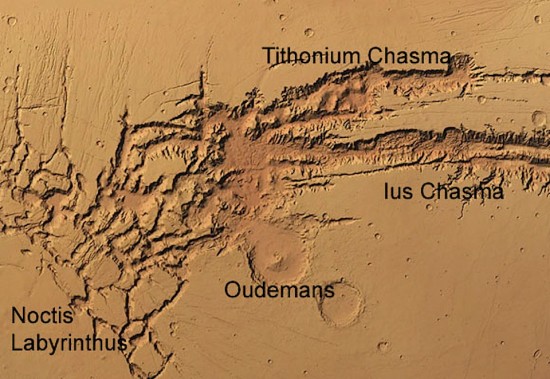Dec 29, 2014
Mars is probably the most intensively studied celestial body. Not even the Moon has been examined in so many ways.
One of the most important questions about other planets is whether water is present in any significant amount. Since water sustains Earth’s ecology, it is presumed that water is essential for life on other planets. Satellite-based imaging systems around Mars are there to look for evidence that water exists, or has existed in the past.
According to a recent press release, planetary scientists have found minerals in a side canyon of Valles Marineris called Ius Chasma that only form in water: jarosite and opal. It is suggested that they formed there in the same way that they form on Earth. It is speculated that sulfur becomes trapped in glacier ice, reacting with water to create acidic sulfate minerals like jarosite.
It is generally believed that Mars is covered with a global layer of permafrost because the annual mean temperature of the soil is approximately – 50 Celsius. It is far colder in the northern and southern latitudes – so cold that carbon dioxide gas freezes into a solid and blankets the terrain with dry ice. Therefore, say planetary scientists, any water “must be” bound up with thick icy soils or locked in frigid underground vaults, because the atmosphere is thin enough for water-ice to sublime directly into vapor and vanish. Since ice rather than liquid water is thought to predominate, it “must have been” Martian glaciers rather than Martian floods that excavated the anomalous terrain.
Periglacial landforms occur on the margins of glaciers. They often appear as polygonal fractures, stone circles, wide pits, scalloped cliffs and dirt-covered mounds of ice. Such features “naturally” appear when ice between soil grains melts and then refreezes from season-to-season. It is conventionally thought that expansion and contraction forces the material to sort itself according to density and size.
The Viking mission orbiter hinted at some large geological structures that looked like they might be of periglacial origin. The resolution of the Viking cameras was too low for any specific details to be analyzed, however. On Earth, glaciers are theorized to create characteristic varves, moraines and loess. Each type of deposit seems to require that mountains of ice, acting like slow-motion bulldozers, push enormous mounds of soil and rock ahead of their billion-ton flanks. In so doing, the gravel and sand is supposed to be sorted by the glacial movement and piled-up into distinctive formations.
As NASA investigators speculate, what else besides glaciers could act with compressive force and sort material into cohesive layers? On Mars, other factors must be included: the formations are often blackened and morphed into “dunes” with deep channels etched into their slopes.
In previous Picture of the Day articles, the signature of powerful electric arcs that once impacted the surface were identified. The incredible energy released by plasma discharges takes the form of sinuous rilles, flat-floored craters, “railroad track” patterns in canyons and craters, intersecting gullies with no debris inside them, giant mesas with Lichtenberg “whiskers” and steep-sided ravines wending through landscapes dotted with circular uplifts.
If what is seen on Mars took place in the presence of planetary lightning bolts and was not the result of ice or water moving across the surface, should ideas about similar observations here on Earth be reconsidered?
Stephen Smith













